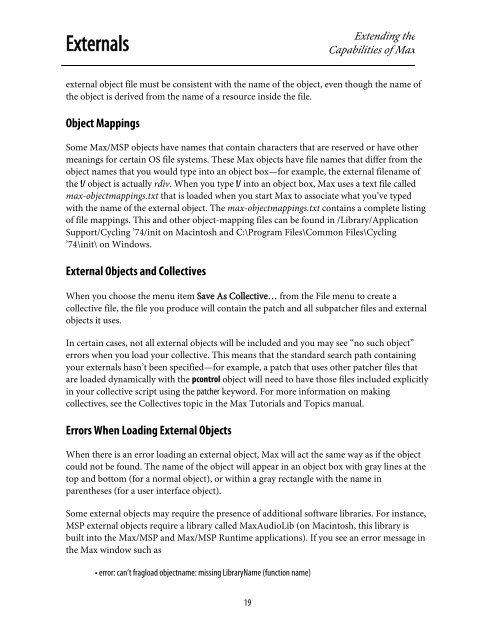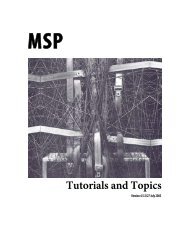Getting Started - Peabody Computer Music
Getting Started - Peabody Computer Music
Getting Started - Peabody Computer Music
Create successful ePaper yourself
Turn your PDF publications into a flip-book with our unique Google optimized e-Paper software.
ExternalsExtending theCapabilities of Maxexternal object file must be consistent with the name of the object, even though the name ofthe object is derived from the name of a resource inside the file.Object MappingsSome Max/MSP objects have names that contain characters that are reserved or have othermeanings for certain OS file systems. These Max objects have file names that differ from theobject names that you would type into an object box—for example, the external filename ofthe !/ object is actually rdiv. When you type !/ into an object box, Max uses a text file calledmax-objectmappings.txt that is loaded when you start Max to associate what you’ve typedwith the name of the external object. The max-objectmappings.txt contains a complete listingof file mappings. This and other object-mapping files can be found in /Library/ApplicationSupport/Cycling ’74/init on Macintosh and C:\Program Files\Common Files\Cycling’74\init\ on Windows.External Objects and CollectivesWhen you choose the menu item Save As Collective… from the File menu to create acollective file, the file you produce will contain the patch and all subpatcher files and externalobjects it uses.In certain cases, not all external objects will be included and you may see “no such object”errors when you load your collective. This means that the standard search path containingyour externals hasn’t been specified—for example, a patch that uses other patcher files thatare loaded dynamically with the pcontrol object will need to have those files included explicitlyin your collective script using the patcher keyword. For more information on makingcollectives, see the Collectives topic in the Max Tutorials and Topics manual.Errors When Loading External ObjectsWhen there is an error loading an external object, Max will act the same way as if the objectcould not be found. The name of the object will appear in an object box with gray lines at thetop and bottom (for a normal object), or within a gray rectangle with the name inparentheses (for a user interface object).Some external objects may require the presence of additional software libraries. For instance,MSP external objects require a library called MaxAudioLib (on Macintosh, this library isbuilt into the Max/MSP and Max/MSP Runtime applications). If you see an error message inthe Max window such as• error: can’t fragload objectname: missing LibraryName (function name)19
















